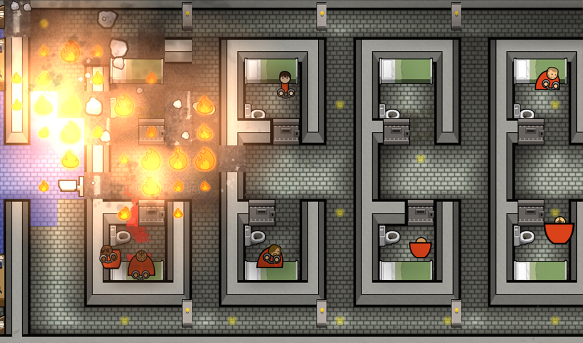“Prison Architect manages to be as enthralling an experience on console as it has been on PC.”
Prison Architect, Introversion Software’s prison management simulator inspired by the stylisations of the Bullfrog days-gone-by, has thrilled PC gamers from the moment it hit early access right up until its final release and beyond. Putting you in charge of a maximum security prison with both serious and comedic themes at play, the game managed to be both taxingly challenging and deviously entertaining simultaneously, providing a captivating all-round experience. Months down the line, Prison Architect is now available on console for both Xbox One and PlayStation 4. Console gamers who have been waiting for this moment will no doubt be keen to know how well the experience has been carried across.
The answer for those people, graciously, is that the transition has gone remarkably well. The process has not been rushed, with a more careful transfer than other recent ports, meriting much better than average results. Before we delve into just how well the game plays on console however, those of you who haven’t played yet might need a little background information to be getting on with. Prison Architect is, as previously mentioned, a prison management simulator which tasks you with building and managing a maximum security prison facility. The game is packed full of detail and has a quirky undertone which allows it to be fun and challenging to play. The model, in essence, is very close to Bullfrog’s classic Theme Hospital. Despite this clear inspiration however, the developers have built Prison Architect from the ground up and made the experience their own.
Prison Architect is packed full of different options for you to create correctional institution of your dreams. From various different types of doors and walls to staffing responsibilities, execution facilities and in-depth security systems, everything you might need is very much at your disposal. Not only that, but every feature in the game has been designed to interact with every other one, giving you total control of your prison both pre and post-construction. Random events however ensure that the game is never too easy and certainly isn’t predictable, making it very replayable and keeping things interesting for many, many hours of gameplay. Whether it is a stealthy escape by an inmate or a deadly brawl involving all of them all, there is always something that can go wrong, and always some problem to solve. This maintains the excitement factor that the game creates from the offset.
Prison Architect is about as close as you can get to a modern Bullfrog-style game, and that is saying something. Introversion Software bring the old style model into the modern age with gusto, and transform it significantly to make adopt it to be their own. Significant levels of depth, interactivity and openness are added to the already working system, making it a more substantial game for a more expectant market. The carefully developed, simple but effective style does a lot to keep the focus on the design and management sides of the game, ensuring that not too much attention has been deviated from gameplay in favour of aesthetics. That being said, no level of detail is sacrificed, with fleshed out missions and unique bios for every inmate you take in being readily available to entertain you. Game mechanics are strong all-round too, with a very intelligent AI bringing your prison to life in all of its 2D glory. Prisoners follow rules to a point, but always have a chance of deviating from them. Guards follow patrols to a tee, so it is up to you to manage them properly. Builders prioritise and work together as a unit, just as you would expect of them. When the cogs are in motion in Prison Architect, the experience which plays out in front of you is a very well-oiled machine indeed.
The main issue which might have arisen in moving the strategic management sim from PC to console was, as ever, the working UI. The system worked well on PC, but the transition from keyboard and mouse controls to a gamepad can often break an otherwise immersive video game experience. In Prison Architect’s case, this is not true at all. In fact, and PC gamers will have to forgive me for saying this, some of the systems felt somewhat improved. Laying out a building felt like a much smoother experience, partly due to updates but also down to a careful redesign for the console release. Accessing menus was faster too, but they were not always easier to navigate once you get into them. Prison Architect on console does a better job of menu navigation than many games of its kind, but it still doesn’t feel like a wholly natural transition. As a whole though, the system works, and surprisingly well at that.
Prison Architect manages to be as enthralling an experience on console as it has been on PC. That is some sort of achievement; especially for a game with a strategy game layout. The hard work which has been put into the transition has made it more than just a straight port, resulting instead in a clean, working and enjoyable game. I implore anyone who is yet to play Prison Architect to pick it up and give it a go. Incredible depth laid upon a simplistic but easy-to-appreciate style allows Prison Architect to emulate a format of gameplay that once seemed lost but now feels more alive than ever. By this point I think you know what to do. Now go and show those inmates who’s boss!














You must be logged in to post a comment.